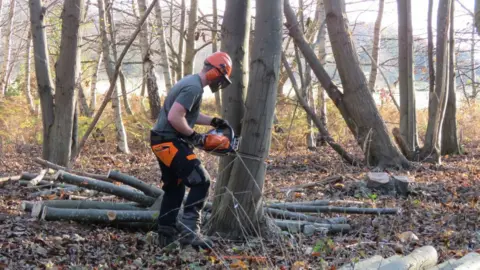Ancient methods help wildlife at burial site
 National Trust/Darren Olley
National Trust/Darren OlleyAncient woodland management techniques have been used to tackle climate change and increase biodiversity at an important Anglo-Saxon archaeological site.
Since introducing coppicing and thinning at Sutton Hoo in Suffolk the site has seen an increase in wildlife and wildflowers, including the endangered Nightingale songbird.
Sutton Hoo is thought to be the final resting place of King Raedwald, who ruled East Anglia in the 7th Century.
The trust said by also reusing the felled timber it was able to reduce its carbon footprint.
Coppicing is a process of felling trees at their base to create a stool where new shoots will grow.
Thinning involves taking about 30% of the trees out of woodland over a 10-year period to increase regeneration and light levels.
The site is also reusing the felled timber.
Jonathan Plews, area ranger at Sutton Hoo, said: “On first glance, coppicing does look quite severe, but by removing the canopy for a few years, we can allow increased light levels and warmth into the ground.
"This increases germination rates in the soil and encourages saplings, wildflowers and other specialist species, such as bramble, to come through.”
The reintroduction of traditional techniques is part of a transition from the site's plantation style woodland to a more native woodland.
 National Trust/Jonathan Plews
National Trust/Jonathan PlewsPlantation woodland is usually grown as a crop to meet the demand for certain types of timber.
Whereas native woodland occurs more naturally and develops over time, to offer a greater variety of species, ages, structure and light.
Since active woodland management started, the site has noticed an increase in the number of nightingales.
Four pairs were recorded at Sutton Hoo in 2024.
The species has seen a population decline of 90% in the last 50 years leaving about 5,500 breeding males.
It is now listed among the UK's most threatened birds, featuring on the RSPB's red list.
Within a year of coppicing being reinstated, the ranger team has also seen an increase in other wildlife and wildflowers in woodland.
The felled timber is being used to produce gates, fencing, signage and benches on the estate and create gifts which can be sold.
Matt Wilson, countryside manager for the National Trust’s Suffolk & Essex portfolio, said the techniques allowed it to "support vital habitats for wildlife and increase biodiversity, but also look at how we can better and more sustainably manage our sites in response to climate change".
Follow Suffolk news on BBC Sounds, Facebook, Instagram and X.
